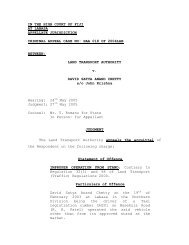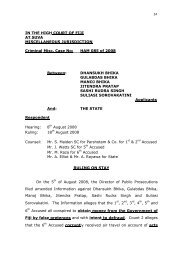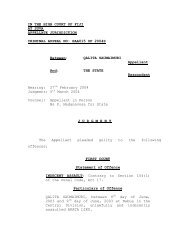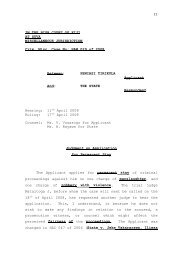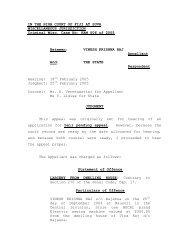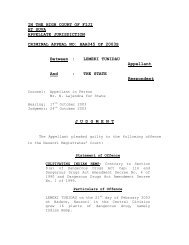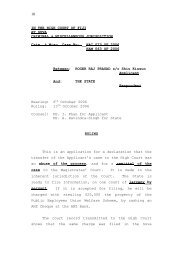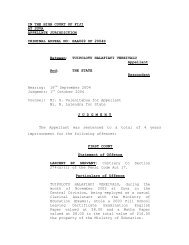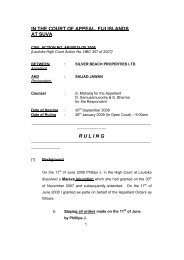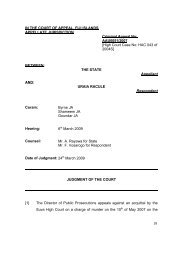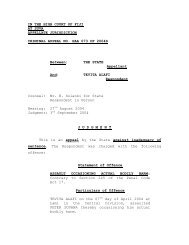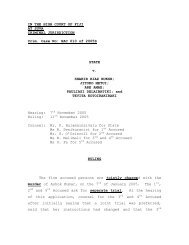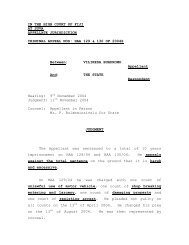State v Senivalati Ramuwai and Others HAC033X.05S - Law Fiji
State v Senivalati Ramuwai and Others HAC033X.05S - Law Fiji
State v Senivalati Ramuwai and Others HAC033X.05S - Law Fiji
Create successful ePaper yourself
Turn your PDF publications into a flip-book with our unique Google optimized e-Paper software.
9<br />
IN THE HIGH COURT OF FIJI<br />
AT SUVA<br />
CRIMINAL JURISDICTION<br />
Criminal Case No: HAC 033 of 2005<br />
STATE<br />
v.<br />
SENIVALATI RAMUWAI<br />
RUPENI NAISORO<br />
NEMANI TUICAKAU<br />
Hearing: 8 th May 2007<br />
Ruling: 9 th May 2007<br />
Counsel:<br />
<strong>State</strong><br />
Mr. D. Toganivalu & S. Vodokisolomoni for<br />
Ms S. Vaniqi for 1 st Accused<br />
Mr. S. Valenitabua for 2 nd Accused<br />
Mr. A. Naco for 3 rd Accused<br />
Ruling on No Case to Answer<br />
The 2 nd <strong>and</strong> 3 rd Accused submit that there is no<br />
case for them to answer. The 2 nd Accused agrees that<br />
if his admissions to the police continue to be part of<br />
the evidence, then there is a case for him to answer.<br />
However he asks me to revisit my earlier ruling on the<br />
trial within a trial, <strong>and</strong> to now exclude the<br />
admissions. Without those admissions, he submits,<br />
there is no case for him to answer. The 3 rd Accused<br />
submits that the circumstantial evidence fails to<br />
implicate him in the offence of murder, <strong>and</strong> that<br />
therefore there is no case to answer.
9<br />
The test at this stage of a criminal trial in the<br />
High Court is set out in section 293 of the Criminal<br />
Procedure Code. That section provides:<br />
“(1) When the evidence of the witnesses<br />
for the prosecution has been concluded,<br />
<strong>and</strong> the statement or evidence (if any)<br />
of the accused person before the<br />
committing court has been given in<br />
evidence, the court, if it considers<br />
that there is no evidence that the<br />
accused or anyone of several accused<br />
committed the offence, shall, after<br />
hearing, if necessary, any arguments<br />
which the legal practitioner for the<br />
prosecution or the defence may desire<br />
to submit, … record a finding … of not<br />
guilty.<br />
(2) When the evidence of the witnesses<br />
for the prosecution has been concluded,<br />
<strong>and</strong> the statement or evidence (if any)<br />
of the accused person before the<br />
committing court has been given in<br />
evidence, the court, if it considers<br />
that there is evidence that the accused<br />
person or anyone or more of several<br />
accused persons, committed the offence,<br />
shall inform each such accused person<br />
of his right to address the court,<br />
either personally or by his legal<br />
practitioner (if any), to give evidence<br />
on his own behalf, or to make an<br />
unsworn statement, <strong>and</strong> to call<br />
witnesses in his defence, <strong>and</strong> in all<br />
cases shall require him or his legal<br />
practitioner (if any), to state whether<br />
it is intended to call any witnesses s<br />
to fact other than the accused person<br />
himself. Upon being informed thereof,<br />
the judge shall record the same. If<br />
such accused person says that he does<br />
not mean to give evidence or make an<br />
unsworn statement, or to adduce<br />
evidence, then the legal practitioner<br />
for the prosecution may sum up the case<br />
against such accused person. If such
9<br />
accused person says that he means to<br />
give evidence or make an unsworn<br />
statement, or to adduce evidence, the<br />
court shall call upon such accused<br />
person to enter upon his defence.”<br />
The test is whether there is evidence in respect<br />
of each ingredient of the offence. As was said in<br />
Sisa Kalisoqo v. <strong>State</strong> Crim. App. No. 52 of 1984 <strong>and</strong><br />
<strong>State</strong> v. Mosese Tuisawau Crim. App. No. 14 of 1990, if<br />
there is some relevant <strong>and</strong> admissible evidence, direct<br />
or circumstantial, touching all the elements of the<br />
offence, then there is a prima facie case. That is<br />
the test in a criminal trial in the High Court when<br />
the prosecution has closed its case.<br />
The 2 nd<br />
Accused<br />
There can be no dispute that in the tendered<br />
caution interview purportedly made by the 2 nd Accused,<br />
there is evidence of a prima facie case. In it, after<br />
Q71 <strong>and</strong> 72, the 2 nd Accused, allegedly under pressure,<br />
took part in a series of acts which led to the death<br />
of the deceased. To what extent he acted under<br />
compulsion, <strong>and</strong> to what extent the interview is a<br />
reliable set of facts, are issues for the assessors.<br />
Counsel however asks me to revisit the question<br />
of the admissibility of the confession on the basis<br />
that the court has now heard Moape Kadavu’s evidence<br />
<strong>and</strong> on the basis that there is now compelling evidence<br />
of police unfairness <strong>and</strong> pressure.<br />
I accept that a court can reconsider an earlier<br />
ruling at any time during the trial. In R v.<br />
Sat-Bhambra 88 Cr. App. R. 55 it was held that once a
9<br />
confession was ruled admissible, the judge could not<br />
re-open the question of oppression or lack of<br />
reliability (under section 76 of the Police <strong>and</strong><br />
Criminal Evidence Act U.K.) but could direct the jury<br />
to disregard the statement or to consider certain<br />
matters relevant to the weight to be attached to the<br />
statement, or if this was not possible without<br />
residual prejudice, he could discharge the jury <strong>and</strong><br />
hold a trial de novo. I adopt the same principles for<br />
the purpose of these submissions.<br />
Moape Kadavu gave a statement to the police on<br />
the 9 th of June 2005, in which he implicated the 1 st ,<br />
2 nd <strong>and</strong> 3 rd Accused. According to the evidence of the<br />
investigating officer Corporal Vijendra N<strong>and</strong>, Kadavu<br />
made a verbal statement to him, the day before (on the<br />
8 th of June) <strong>and</strong> was told to go home <strong>and</strong> return the<br />
next day to make a written statement. Earlier, on the<br />
2 nd of May 2005, Kadavu had made a statement that he<br />
had picked the 2 nd Accused up from the Matacula road,<br />
taken him to Namau where Kadavu had dropped a<br />
passenger, <strong>and</strong> then dropped the 2 nd Accused at his home<br />
in Mayawasara. On his way back to Korovou, he saw the<br />
deceased’s van being driven towards Matacula after<br />
8pm. In his sworn evidence in court, Kadavu<br />
maintained the story of the 2 nd of May. That story was<br />
inconsistent with the 2 nd Accused’s caution interview<br />
<strong>and</strong> in effect provides the 2 nd Accused with an alibi.<br />
Kadavu’s second statement implicated all three accused<br />
<strong>and</strong> is broadly consistent with the 2 nd Accused’s<br />
caution statement from Q71.<br />
Kadavu was declared hostile <strong>and</strong> was<br />
cross-examined.<br />
Under cross-examination he said that
9<br />
on the 3 rd of May 2005, he was taken to the Korovou<br />
Police Station where he was threatened with assault by<br />
police officers. Under cross-examination by <strong>State</strong><br />
counsel, he said that he had been threatened by one<br />
Constable Iosefo on the 8 th of June <strong>and</strong> told to admit<br />
that he had met the three accused, or he would be<br />
locked up <strong>and</strong> beaten.<br />
Under cross-examination by Ms Vaniqi, he<br />
maintained this position. Under cross-examination by<br />
Mr. Valenitabua, he gave evidence of the truth of this<br />
first statement, <strong>and</strong> said that his second statement<br />
was forced out of him.<br />
Counsel for the 2 nd Accused submits that when the<br />
2 nd Accused’s alibi was checked, <strong>and</strong> the interviewed<br />
re-commenced at 2.30pm at Nausori Police Station, the<br />
2 nd Accused was told that Kadavu had implicated him.<br />
This was false <strong>and</strong> the remaining parts of the 2 nd<br />
Accused’s statement was therefore unfairly obtained.<br />
The evidential value of the testimony of a<br />
hostile witness is a matter for the assessors, after<br />
they have been directed to exercise extreme caution in<br />
accepting any part of his evidence. This is because<br />
he has given two different accounts of events, <strong>and</strong><br />
witnesses who change their evidence (for whatever<br />
reason) are not always reliable. Although at “no<br />
case” stage, a judge is not required to assess the<br />
credibility of witnesses, such assessment is<br />
inevitable when considering whether a confession ought<br />
to be placed before the assessors. The question for<br />
me is whether Kadavu’s evidence creates a reasonable<br />
doubt about the voluntariness <strong>and</strong> fairness of the 2 nd
9<br />
Accused’s statement to the police.<br />
In my view, it does not. Kadavu did not allege<br />
assault or pressure on the 2 nd or 3 rd of May, when he<br />
gave evidence in the trial proper. He alleged<br />
pressure on the 8 th of June 2005. The police evidence<br />
about the way in which the 2 nd Accused’s statement was<br />
obtained remained unaltered. The police evidence was<br />
that the 2 nd Accused was treated fairly <strong>and</strong> that when<br />
confronted with a false alibi, he started to confess<br />
at 2.30pm on the 3 rd of May 2005. The weight to be<br />
given to Kadavu’s evidence will affect the question of<br />
the reliability of the confession at the end of trial.<br />
I do not consider that his evidence affects my ruling<br />
on admissibility.<br />
There is a case to answer for the 2 nd Accused.<br />
The 3 rd<br />
Accused<br />
The evidence against the 3 rd Accused is<br />
circumstantial. He made no admissions to the police<br />
but there is some evidence from his police statement<br />
that he was not in the Top Taste restaurant at the<br />
time of the murder of the deceased.<br />
The question for me is whether taking all the<br />
circumstantial evidence together, there is relevant<br />
<strong>and</strong> admissible evidence implicating the accused in<br />
relation to the offence charged.<br />
The 3 rd Accused according to the prosecution case,<br />
was seen drinking at the Korovou Club from 6pm. At<br />
about 7pm he was seen at the Top Taste Restaurant with
9<br />
another man to drink further. The 3 rd Accused was seen<br />
at the Tailevu Hotel with the 1 st Accused <strong>and</strong> some<br />
other men until 9pm. He then went to the Tailevu<br />
Hotel. He met the 1 st Accused after 10pm. In the<br />
early hours of the 30 th of April, the 3 rd Accused was<br />
seen near the bridge at Korovou with the 1 st Accused.<br />
In his statement of the 3 rd of August the 3 rd<br />
Accused said he had been drinking with one Vuniani<br />
Vasuca from 4pm on the 29 th of April, at the Tailevu<br />
Club. The 1 st accused was also there. When the Club<br />
closed he went to the Top Taste restaurant with a<br />
“young man from Navunisole <strong>and</strong> the young man from<br />
Gau.” He was then confronted with William Naitaka<br />
from Navunisole who said that “he did not accompany<br />
you to the Tailevu Hotel after drinking at the Top<br />
Taste restaurant.” The 3 rd Accused agreed to this. He<br />
denied going to the Tailevu Hotel with the 1 st Accused,<br />
saying he had gone with the man from Gau. He denied<br />
going to the Top Taste restaurant with the 1 st Accused<br />
at 7pm, <strong>and</strong> he denied being with the 1 st Accused at<br />
midnight when he was allegedly seen by Simione<br />
Momoivalu at the bridge in Korovou. He also denied<br />
being with the 1 st Accused at 9.30pm near the Tailevu<br />
Hotel but later admitted when confronted by Mesake<br />
Tabaka that he had been near the hotel. However he<br />
denied being with the 1 st Accused.<br />
It is not my duty at this stage of the trial to<br />
assess whether the evidence of the police statements<br />
is reliable, or the evidence of the prosecution<br />
witnesses. The prosecution case is that between 9 <strong>and</strong><br />
9.30pm the deceased was murdered near the Matacula old<br />
road junction at Korovou. The evidence of Tevita
9<br />
Matakitogo is that he saw the 1 st <strong>and</strong> 3 rd Accused<br />
together between 9.30pm <strong>and</strong> 10pm at the Tailevu Hotel.<br />
That was the first time he had seen the 3 rd Accused.<br />
The evidence of Mesake Tabaka was that the same two<br />
men who had been drinking together at the Club until<br />
9pm were at the Tailevu Hotel at 10.30pm. At 12<br />
midnight, Simione Momoivalu saw the 1 st <strong>and</strong> 3 rd Accused<br />
coming down from the Tailevu Hotel towards the bridge.<br />
The question for the assessors, in a case of<br />
circumstantial evidence is whether, taking all the<br />
evidence together, the only reasonable conclusion to<br />
be drawn, is the guilt of the accused. The question<br />
is whether there is any other inference to be drawn,<br />
which is equally consistent with his innocence.<br />
Assuming therefore that all the prosecution<br />
witnesses are reliable in their identification of the<br />
3 rd Accused, <strong>and</strong> assuming the reliability of the 3 rd<br />
Accused’s statements to the police, the evidence is<br />
that the 3 rd Accused was seen with the 1 st Accused from<br />
about 6pm on the 29 th of April to 12 midnight. They<br />
were not always together. He was seen alone at the<br />
Top Taste at about 7pm. But he was with the 1 st<br />
Accused at about 9pm <strong>and</strong> with him at 10.30pm. It is<br />
difficult to put a time on his visits to the Top Taste<br />
restaurant but the police statement suggests that he<br />
was there after 9pm <strong>and</strong> before 10pm. The<br />
confrontation with William Naitaka does not contradict<br />
his visit to the Top Taste. It only contradicts his<br />
story about going to the Tailevu Hotel with Naitaka.<br />
However his statement of the 5 th of May does not<br />
specifically say that he went with Naitaka. It<br />
appears to refer only to a young man from Gau who has
9<br />
remained nameless <strong>and</strong> unknown. He agreed that he met<br />
the 1 st Accused at the Hotel at about 10pm.<br />
The evidence therefore discloses an entire<br />
evening of drinking heavily with several men. In the<br />
course of the drinking, the 1 st <strong>and</strong> 3 rd Accused were<br />
indeed seen together. However there is no evidence at<br />
all that the 3 rd Accused was in the deceased’s van, or<br />
that he left Korovou town, or that he knew of any plan<br />
to assault the deceased. Taking all the evidence<br />
together, there are many inferences which could be<br />
drawn which are entirely consistent with the 3 rd<br />
Accused’s innocence. The most obvious is that he was<br />
at the Top Taste restaurant, or at the Tailevu Hotel<br />
when the murder occurred. William Naitaka did not<br />
deny being at the Top Taste with the 3 rd Accused, he<br />
only denied going on to the Hotel with him.<br />
The evidence implicating the 3 rd Accused does not<br />
go beyond evidence of association with <strong>and</strong> drinking<br />
with the 1 st Accused. In making this assessment, I do<br />
not draw any conclusions about the reliability of the<br />
prosecution evidence. I have assumed for instance<br />
that the first-time dock identification of the 3 rd<br />
Accused by Mesake Tabaka is accurate <strong>and</strong> reliable, <strong>and</strong><br />
that Simione Momoivalu did indeed see the 1 st <strong>and</strong> 3 rd<br />
Accused together at midnight on the 29 th of April.<br />
On all the evidence of the prosecution I cannot<br />
say that there is any evidence implicating the 3 rd<br />
Accused in the offence charged. Suspicion <strong>and</strong><br />
association cannot be enough to put an accused person<br />
to his defence.
9<br />
I find therefore that there is no evidence that<br />
the 3 rd Accused was involved in the murder of Navneet<br />
Kumar <strong>and</strong> I find him not guilty. He is acquitted of<br />
the offence charged. He may st<strong>and</strong> down.<br />
Nazhat Shameem<br />
JUDGE<br />
At Suva<br />
9 th May 2007



